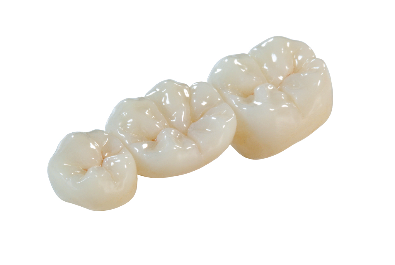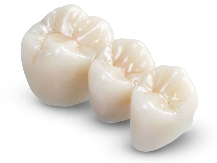Bridge
A bridge works as series of connected crowns, replacing missing teeth (pontic) by bridging the gap and using surrounding teeth (abutments) as support.
If you are missing one or more natural teeth, then you know how much this diminishes your chewing ability. What you may not realise is that missing teeth also affect facial structure, increasing stress on remaining teeth and can often give your cheeks a sunken appearance.
If there is sufficient structure remaining on surrounding teeth, we can make a bridge to replace the missing tooth/teeth. Replacing your missing teeth with bridge work can restore your chewing ability and help to restore your facial contour.
Once permanently cemented in your mouth, bridgework can look, feel and function in the same way as your natural teeth.
Types of Dental Bridge available
Traditional Fixed Bridge - the most commonly used type of bridge, which is made up of a pontic which is fused between two porcelain crowns, anchored to neighbouring teeth or implants. The pontic is usually made of porcelain fused to metal or ceramic. This type of bridge is fixed and cannot be removed.
Resin-Bonded/Maryland Bridge - this bridge is used to fill the gap between teeth when there are strong teeth either side of a missing tooth. A metal wing which will support the missing tooth will be bonded to the back of you tooth. This type of bridge sometimes involves no preparation to adjacent teeth.
Cantilever Bridge - a cantilever bridge can be used to replace a missing tooth (pontic) which is fixed to a crown placed over an adjacent tooth (retainer). The cantilever bridge can be used where it is necessary to involve only one supporting tooth (retainer). Although additional teeth can be used on the same side to increase retention and stability of the bridge.



